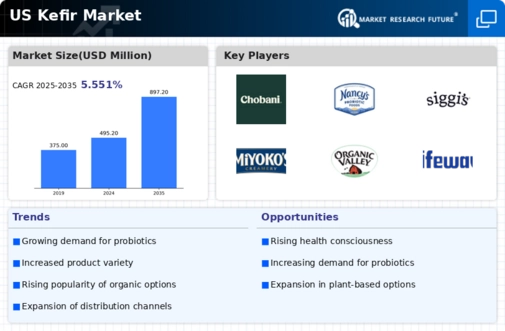Emergence of Diverse Flavor Profiles
The kefir market is evolving with the emergence of diverse flavor profiles that cater to a wide range of consumer tastes. Manufacturers are innovating by introducing flavored kefir options, such as fruit-infused varieties and savory blends, which appeal to both traditional and adventurous consumers. This trend is supported by market data indicating that flavored dairy products have seen a growth rate of approximately 8% in recent years. By diversifying flavor offerings, brands can attract a broader audience and encourage trial among consumers who may be hesitant to try plain kefir. This innovation in flavor is likely to enhance the overall appeal of the kefir market.
Rising Demand for Probiotic Products
The kefir market is experiencing a notable increase in demand for probiotic-rich foods. Consumers are becoming increasingly aware of the health benefits associated with probiotics, such as improved gut health and enhanced immune function. This trend is reflected in market data, indicating that the probiotic food segment is projected to grow at a CAGR of approximately 7.5% over the next five years. As a result, the kefir market is likely to benefit from this rising consumer interest, with more individuals seeking out kefir products as a natural source of probiotics. The growing emphasis on preventive healthcare further fuels this demand, as consumers prioritize products that contribute to overall well-being.
Consumer Education on Health Benefits
There is a growing emphasis on consumer education regarding the health benefits of kefir, which is positively influencing the kefir market. Health professionals and nutritionists are increasingly recommending kefir as a beneficial addition to diets, particularly for its probiotic content. This educational push is reflected in various health campaigns and social media initiatives aimed at informing consumers about the advantages of incorporating kefir into their daily routines. As awareness increases, it is likely that more individuals will seek out kefir products, thereby driving market growth. The kefir market stands to gain from this trend as consumers become more informed about their dietary choices.
Increased Availability of Kefir Products
The kefir market is witnessing an expansion in product availability, driven by the growing presence of kefir in retail outlets and online platforms. Major grocery chains are increasingly stocking a variety of kefir products, catering to diverse consumer preferences. Data indicates that the retail distribution of kefir has increased by approximately 15% in the past year alone. This enhanced accessibility is likely to attract new consumers who may not have previously considered kefir as part of their diet. Furthermore, the rise of e-commerce platforms has facilitated the purchase of kefir products, allowing consumers to explore different brands and flavors conveniently.
Shift Towards Natural and Organic Products
In the current landscape, there is a marked shift towards natural and organic food products, which significantly impacts the kefir market. Consumers are increasingly scrutinizing ingredient lists and favoring products that are free from artificial additives and preservatives. This trend is supported by data showing that organic food sales in the US have risen by over 10% annually. As a result, kefir brands that emphasize organic certification and natural ingredients are likely to capture a larger share of the market. This consumer preference aligns with a broader movement towards sustainability and health-conscious eating, positioning the kefir market favorably in a competitive environment.




















Leave a Comment